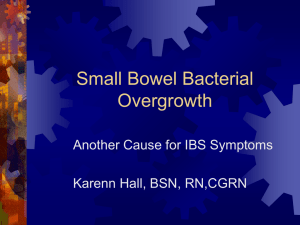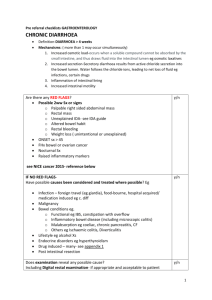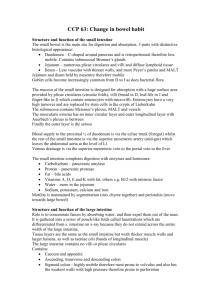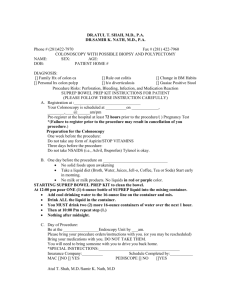Bowel Physiology - Wound Ostomy and Continence
advertisement
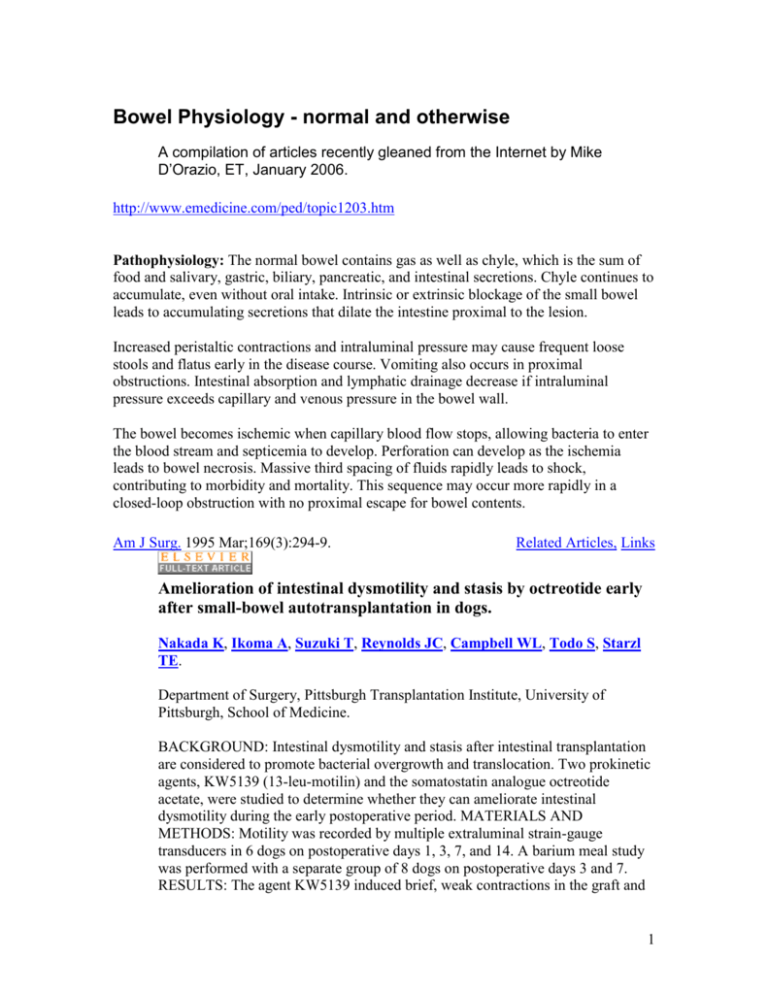
Bowel Physiology - normal and otherwise A compilation of articles recently gleaned from the Internet by Mike D’Orazio, ET, January 2006. http://www.emedicine.com/ped/topic1203.htm Pathophysiology: The normal bowel contains gas as well as chyle, which is the sum of food and salivary, gastric, biliary, pancreatic, and intestinal secretions. Chyle continues to accumulate, even without oral intake. Intrinsic or extrinsic blockage of the small bowel leads to accumulating secretions that dilate the intestine proximal to the lesion. Increased peristaltic contractions and intraluminal pressure may cause frequent loose stools and flatus early in the disease course. Vomiting also occurs in proximal obstructions. Intestinal absorption and lymphatic drainage decrease if intraluminal pressure exceeds capillary and venous pressure in the bowel wall. The bowel becomes ischemic when capillary blood flow stops, allowing bacteria to enter the blood stream and septicemia to develop. Perforation can develop as the ischemia leads to bowel necrosis. Massive third spacing of fluids rapidly leads to shock, contributing to morbidity and mortality. This sequence may occur more rapidly in a closed-loop obstruction with no proximal escape for bowel contents. Am J Surg. 1995 Mar;169(3):294-9. Related Articles, Links Amelioration of intestinal dysmotility and stasis by octreotide early after small-bowel autotransplantation in dogs. Nakada K, Ikoma A, Suzuki T, Reynolds JC, Campbell WL, Todo S, Starzl TE. Department of Surgery, Pittsburgh Transplantation Institute, University of Pittsburgh, School of Medicine. BACKGROUND: Intestinal dysmotility and stasis after intestinal transplantation are considered to promote bacterial overgrowth and translocation. Two prokinetic agents, KW5139 (13-leu-motilin) and the somatostatin analogue octreotide acetate, were studied to determine whether they can ameliorate intestinal dysmotility during the early postoperative period. MATERIALS AND METHODS: Motility was recorded by multiple extraluminal strain-gauge transducers in 6 dogs on postoperative days 1, 3, 7, and 14. A barium meal study was performed with a separate group of 8 dogs on postoperative days 3 and 7. RESULTS: The agent KW5139 induced brief, weak contractions in the graft and 1 had little effect on the dilated bowel; however, octreotide induced motor activity that propelled accumulated intestinal contents into the colon and reduced dilation of the transplanted bowel. CONCLUSION: Octreotide, but not KW5139, ameliorates intestinal dysmotility associated with bowel autotransplantation during the early postoperative period. Short-term administration of octreotide may be useful for the treatment of dysmotility following intestinal transplantation. http://gastroresource.com/GITextbook/en/chapter7/7-2.htm 2. Small Intestinal Motility page 184 The main function of the small intestine is digestion and absorption of nutrients. In this process, the role of small bowel motility is to mix food products with the digestive enzymes, to promote contact of chyme with the absorptive cells over a sufficient length of bowel and finally to propel remnants into the colon. Well-organized motility patterns occur in the small intestine to accomplish these goals in the fed as well as the fasting state. During fasting, a migrating motor complex (MMC) exists. This complex is characterized by a front of intense spiking activity (phase III activity) that migrates down the entire small intestine; as the front reaches the terminal ileum, another front develops in the gastroduodenal area and progresses down the intestine. The purpose of this phase III myoelectric and contractile activity is to sweep remnants of the previous meal into the colon and prevent stagnation and bacterial overgrowth. The MMC often starts in the lower esophagus. Sweeping through the stomach, it removes debris and residual material not emptied with the last meal. Absence of phase III activity is associated with bacterial overgrowth and diarrhea. Thus, the small bowel is active even during fasting. During meals, this cycle is interrupted and the motility pattern in the small bowel becomes an irregular spiking activity called the fed pattern. This fed pattern of motility does not seem to move intestinal contents forward to any great extent but does mix these contents with digestive juices, spreading them again and again over the absorptive surface of the brush border. Diarrhea can thus occur when this normal fed pattern is replaced by aggressive propulsive contractions. http://gastroresource.com/GITextbook/en/chapter7/7-17.htm page 251 17. Bacterial Overgrowth Syndrome The bacterial overgrowth syndrome can result from any disease that interferes with the normal balance (ecosystem) of the small intestinal flora and brings about loss of gastric acidity; alteration in small bowel motility or lesions predisposing to luminal stasis; loss of the ileocecal valve; or overwhelming contamination of the intestinal lumen (Table 16). The bacterial overgrowth syndrome gives rise to clinical abnormalities arising from the pathophysiological effects on the luminal contents and the mucosa. Bacteria can consume proteins and carbohydrates. In bacterial overgrowth there may be defective transport of sugars, possibly related to the toxic effect of deconjugated bile acids. TABLE 16. Etiology of the bacterial overgrowth syndrome Breakdown of normal defense mechanisms Achlorhydria Stasis: Anatomic (Crohn's disease, diverticula, lymphoma, strictures) 2 Functional (scleroderma, diabetic autonomic neuropathy, pseudo-obstruction) Loss of ileocecal valve Contamination Postinfection Enteroenteric fistulas, gastrocolic fistulas Steatorrhea results from the deconjugation and dehydroxylation of bile acids; lithocholic acid is precipitated and free bile acids are reabsorbed passively, making them unavailable and incapable of performing micellar solubilization. There may also be mucosal damage. Fats, cholesterol and fat-soluble vitamins are malabsorbed. Vitamin B12 is also malabsorbed as a result of the binding and incorporation of this vitamin into the bacteria. Folate deficiency, however, is not a common occurrence in bacterial overgrowth; unlike vitamin B12, folate synthesized by microorganisms in the small bowel is available for host absorption. In patients with small bowel bacterial overgrowth, serum folate levels tend to be high rather than low. The enteric bacteria also produce vitamin K, and patients with bacterial overgrowth who are on the anticoagulant warfarin may have difficulty in maintaining the desired level of anticoagulation. In addition to steatorrhea, patients with bacterial overgrowth frequently complain of watery diarrhea. Important mechanisms in producing this diarrhea include (1) disturbances of the intraluminal environment with deconjugated bile acids, and hydroxylated fatty and organic acids; and (2) direct changes in gut motility. In some patients, symptoms of the primary disease predominate, and evidence of bacterial overgrowth may be found only on investigation. In others, the primary condition is symptomless, and the patient presents with a typical malabsorption syndrome due to bacterial overgrowth (Table 17). TABLE 17. Diagnosis of the bacterial overgrowth syndrome Jejunal culture Tests of bile salt deconjugation 14C-glycocholate breath tests In vitro deconjugation assessment Tests of malassimilation Vitamin B12 (Schilling test) D-xylose, glucose, lactulose H2 breath tests Once diagnosis of bacterial overgrowth is suspected a careful history should be performed to identify possible causes. Physical examination may be normal or may demonstrate signs related to specific nutrient deficiencies. A small bowel biopsy is of value in excluding primary mucosal disease as the cause of the malabsorption. Histologic abnormalities of the jejunal mucosa are usually not seen in patients with bacterial overgrowth. The sine qua non for the diagnosis of bacterial overgrowth is a properly collected and appropriately cultured aspirate of the proximal small intestine. Specimens should be obtained under anaerobic conditions and quantitative colony counts determined. Generally, bacteria concentrations of greater than 105 organisms per mL are highly suggestive of bacterial overgrowth. Such methods are difficult and usually undertaken only in a research setting. Alternatively, one can attempt to demonstrate a metabolic effect of the bacterial overgrowth, such as intraluminal bile acid deconjugation by the bile acid or 14C-glycocholate breath test. Cholylglycine-14C (glycine-conjugated cholic acid with the radiolabeled 14C on the glycine moiety) 3 when ingested circulates normally in the enterohepatic circulation without deconjugation. Bacterial overgrowth within the small intestine splits the 14C-labeled glycine moiety and subsequently oxidizes it to 14C-labeled CO2, which is absorbed in the intestine and exhaled. Excess 14CO2 appears in the breath. The bile acid breath test cannot differentiate bacterial overgrowth from ileal damage or resection where excessive breath 14CO2 production is due to bacterial deconjugation within the colon of unabsorbed 14C-labeled glycocholate. This creates clinical difficulties, since bacterial overgrowth may be superimposed on ileal damage in such conditions as Crohn's disease. Breath hydrogen analysis allows a distinct separation of metabolic activity of intestinal flora of the host, since no hydrogen production is known to occur in mammalian tissue. Excessive and early breath hydrogen production has been noted in patients with bacterial overgrowth following the oral administration of either 50 g of glucose or 10 g of lactulose. Another hallmark of bacterial overgrowth is steatorrhea, detected by the 72-hour fecal fat collection. The Schilling test also is abnormal. 57Co-B12 is given with intrinsic factor following a flushing dose of nonradioactive B12 given parenterally to prevent tissue storage of the labeled vitamin. In healthy subjects, 57Co-B12 combines with intrinsic factor and is absorbed and >8% excreted in the urine within 24 hours. In patients with bacterial overgrowth, the bacteria combine with or destroy intrinsic factor, the vitamin or both, causing decreased vitamin B12 absorption. Following treatment with antibiotics the B12 absorption returns to normal. Treatment of bacterial overgrowth involves removing the cause, if possible. The addition of a broad-spectrum antibiotic (tetracycline 250 mg q.i.d., often accompanied by metronidazole 250 mg q.i.d., for 10 days) will often induce a remission for many months. If the cause cannot be eliminated and symptoms recur, good results can be achieved with intermittent use of antibiotics (e.g., one day a week, or one week out of every six). http://journal.diabetes.org/clinicaldiabetes/V18N42000/pg148.htm Diabetes and the Gastrointestinal Tract James D. Wolosin, MD, FACP, and Steven V. Edelman, MD The Small Intestine in Diabetes In some cases of longstanding diabetes, the enteric nerves supplying the small intestine may be affected, leading to abnormal motility, secretion, or absorption. This leads to symptoms such as central abdominal pain, bloating, and diarrhea. Delayed emptying and stagnation of fluids in the small intestine may lead to bacterial overgrowth syndromes, resulting in diarrhea and abdominal pain. Metclopropamide and cisapride may help to accelerate the passage of fluids through the small intestine, whereas broad-spectrum antibiotics will decrease bacterial levels. Diagnosis can be quite difficult and may require small-bowel intubation for quantitative small-bowel bacterial cultures. Breath hydrogen testing and the [14C]-D-xylose test may be helpful in diagnosing bacterial overgrowth as well. All of these tests are somewhat 4 cumbersome, and an empiric trial of antibiotics is often the most efficient means of diagnosing and treating this condition. Numerous antibiotic regimens have been shown to be effective, including 5- to 10-day courses of tetracycline, ciprofloxin, amoxacillin, or tetracycline. A short course may provide prolonged relief, but typically, additional courses of antibiotics are required when symptoms recur in several weeks or months. At times, enteric neuropathy may lead to a chronic abdominal pain syndrome similar to the pain of peripheral neuropathy in the feet. This condition may be very difficult to treat but will sometimes respond to pain medications and tricyclic antidepressant medications, such as amitryptilline (Elavil). Unfortunately, narcotic addiction may be common in patients with chronic painful enteric neuropathy. Individuals with diabetes also have an increased risk of celiac sprue. In this condition, an allergy to wheat gluten develops, leading to inflammation and thinning of the mucosa of the small intestine. Why this association occurs is not clear. However, sprue may lead to diarrhea, weight loss, and malabsorption of food. This condition responds well to a gluten-free diet, but patients may have difficulty adhering to such a diet. Diagnosis can be made with endoscopic biopsy of the small intestine or with serological evaluation for anti-endomysial and anti-gliadin antibodies. The Colon in Diabetes Limited information is available regarding the effects of diabetes on the large intestine. We do know that enteric neuropathy may affect the nerves innervating the colon, leading to a decrease in colon motility and constipation. Anatomic abnormalities of the colon, such as structure, tumor, or diverticulitis, should be excluded with a barium enema or colonoscopy. Fiber supplementation with bran or psyllium products, as well as a high-fiber diet, increases the water content of the bowel movement and may relieve constipation. Mild laxatives and stool softeners will often help as well. In addition, cisapride accelerates colonic movement and may increase the frequency of bowel movements. Diabetic Diarrhea Patients with a longstanding history of diabetes may experience frequent diarrhea, and this has been reported to occur in up to 22% of patients. This may be related to problems in the small bowel or colon. Abnormally rapid transit of fluids may occur in the colon, leading to increased stool frequency and urgency. In addition, abnormalities in the absorption and secretion of colonic fluid may develop, leading to increased stool volume, frequency, and water content. Diabetic diarrhea is a syndrome of unexplained persistent diarrhea in individuals with a longstanding history of diabetes. This may be due to autonomic neuropathy leading to abnormal motility and secretion of fluid in the colon. There are also a multitude of 5 intestinal problems that are not unique to people with diabetes but that can cause diarrhea. The most common is the irritable bowel syndrome. The workup and treatment of diarrhea is similar in patients with or without diabetes. If the basic medical evaluation of diarrhea is nondiagnostic, which it frequently is, then treatment is tailored toward providing symptomatic care with antidiarrheal agents such as diphenoxylate (Lomotil) or loperamide (Immodium). Fiber supplementation with bran, Citrucel, Metamucil, or high-fiber foods may also thicken the consistency of the bowel movement and decrease watery diarrhea. In addition, antispasmodic medicines such as hyosymine (Levsin), dicyclomine (Bentyl), and chordiazepoxide (Librax)/clindinium (Clindex) may decrease stool frequency. Sometimes an empiric trial of antibiotics and/or pancreatic enzymes is warranted because pancreatic exocrine insufficiency and bacterial overgrowth may be the etiology. More recently, the 5HT3 receptor antagonist alosetron (Lotronex) has been used effectively for the treatment of diarrhea-predominant irritable bowel syndrome. Tincture of opium and paregoric have also been used to improve the quality of daily life in some cases. Finally, in severe cases, injections of octreotide (Sandostatin), a somatostatin-like hormone, have been shown to significantly decrease the frequency of diabetic diarrhea. Obviously, in these severe cases, referral to a gastroenterologist is indicated. http://www.wjgnet.com/1007-9327/5/518.asp ISSN 1007-9327 CN 14-1219/R World J Gastroenterol 1999; December 5(6):518-521 Intestinal stasis associated bowel inflammation Shunichiro Komatsu, Yuji Nimura, D Neil Granger Anatomical structures that create reservoirs for stagnant intestinal contents are a characteristic feature of common inflammatory disorders such as diverticulitis and appendicitis. Intestinal diverticula, surgically constructed blind loops and pouches, obstructing carcinomas of the colon, and Hirschsprung’s disease are accompanied by chronic inflammatory changes in the intestine, and are occasionally associated with mucosal ulceration followed by massive bleeding. These diseases are etiologically associated with disorders characterized by intestinal stasis and/or an altered fecal stream, resulting from “cul de sac” structures (blind loop or pouch) in the intestinal tract, bowel obstruction or impaired motility. Furthermore, some of these chronic inflammatory conditions appear to exhibit similar pathological features, such as ischemic colitis. Although these inflammatory changes have been described individually, often as case reports, relatively little attention has been devoted to the overall clinical impact of these diseases and to understanding the pathophysiology of disease initiation and progression. Studies in our laboratory and by others have provided novel insights into the molecular and cellular basis for the intense inflammatory responses that are associated with intestinal stasis. This review summarizes the findings of these studies and provides a unifying theory to explain the inflammatory responses that result from intestinal stasis. Restorative proctocolectomy with ileal pouch anal anastomosis has become the surgical treatment of choice for both ulcerative colitis and familial adenomatous polyposis. In spite of the excellent functional results and improved quality of life with this procedure, major concerns persist regarding the risks for and consequences of ileal pouchitis, a long term complication that 6 is recognized with increasing frequency. Pouchitis is a nonspecific inflammation of an ileal reservoir that typically results in increased bowel frequency, decreased stool consistency, diminished continence, low-grade fever, malaise, and arthralgias. Oral treatment with antibiotics, such as metronidazole, is an effective therapy for active pouchitis[10-12]. http://216.239.51.104/search?q=cache:UGsccrrxJacJ:medind.nic.in/maa/t03/i4/maat03i4p 306.pdf+adaptive+changes+small+bowel+stasis&hl=en http://216.239.51.104/search?q=cache:DLCdzBr4qb8J:www.hindawi.net/access/get.aspx %3Fjournal%3Dmi%26volume%3D7%26pii%3DS0962935198000337+adaptive+chang es+small+bowel+stasis&hl=en Pouchitis mini review Appl. Environ. Microbiol., 01 1992, 111-118, Vol 58, No. 1 Copyright © 1992, American Society for Microbiology Changes in bacterial composition and enzymatic activity in ileostomy and ileal reservoir during intermittent occlusion: a study using dogs JG Ruseler-van Embden, WR Schouten, LM van Lieshout and HJ Auwerda Department of Immunology, Erasmus University, Rotterdam, The Netherlands. Bacterial flora, activities of 10 potential mucus- and dietary polysaccharide-degrading enzymes, blood group antigenicity of the intestinal glycoproteins, and proteolytic activity in the output from experimentally colectomized dogs with conventional ileostomies and dogs with valveless ileal reservoirs (pouches) were determined. The ileostomies of dogs with conventional surgery (group II) and with pouches (group III) were occluded intermittently during a 6-week period. The duration of occlusion was progressively increased. Group I, five dogs with conventional ileostomies, served as a control group. After occlusion of the ileal pouch for 7 h, total numbers of bacteria increased threefold, glycosidase activity increased fivefold, and blood group antigenicity of the intestinal glycoproteins, which was high in the output from the nonoccluded pouch, was no longer detectable. Proteolytic activity was not influenced by occlusion of the pouch. Significantly lower numbers of bacteria, only minor glycosidase activity, high blood group antigenicities of the intestinal glycoproteins, and higher proteolytic activity were found in ileostomy effluents from groups I and II. Histopathological examination showed chronic inflammation and changes in crypt-villus ratio in all dogs with ileal reservoirs; the ileal mucosa from the dogs with conventional ileostomies did not show any abnormalities. Consequences of the flora- related enzyme activities for the ileal mucosa are discussed. http://www.ncbi.nlm.nih.gov/entrez/query.fcgi?cmd=Retrieve&db=PubMed&list_uids=8 959733&dopt=Citation Neurogastroenterol Motil. 1996 Dec; 8(4):277-97. Related Articles, Links Biomechanics of the gastrointestinal tract. 7 Gregersen H, Kassab G. Centre of Biomechanics and Motility, Skejby University Hospital, Denmark. As the function of the gastrointestinal tract is to a large degree mechanical, it has become increasingly popular to acquire distensibility data in motility research based on various parameters. Hence it is important to know on which geometrical and mechanical assumptions the various parameters are based. Currently, compliance and tone derived from pressure-volume curves are by far the most often used parameters. However, pressure-volume relations obtained in tubular organs must be carefully interpreted as they provide no direct measure of luminal cross-sectional area and other variables useful in plane stress and strain analysis. Thus, erroneous conclusions concerning tissue distensibility may be deduced. Other parameters, such as wall tension, stress and strain, give more useful information about mechanical behaviour. Distensibility data procure significance in fluid mechanics and in the study of tone, peristaltic reflexes, and mechanoreceptor kinematics. Such data are needed for the determination of the interaction between stimulus, electrical responses in neurons and the mechanical behaviour of the gut. Furthermore, from a clinical perspective, investigation of visco-elastic properties is important because GI diseases are associated with growth and remodeling. For example, prestenotic dilatation, increased collagen synthesis, dysmotility and altered distensibility are common features of obstructive diseases. The purpose of this review is to discuss the physiological and clinical importance of acquiring biomechanical data, distensibility parameters and interpretation of these results and their associated errors. We will also discuss some aspects of the relationship between morphology, growth and biomechanics. Finally, we will outline a number of techniques to study the mechanical properties of the GI tract. http://www.smi.hst.aau.dk/visceralpainbiomechanics/main.html Laboratory for Visceral Pain and Biomechanics Studying sensation and biomechanics in visceral organs http://content.karger.com/ProdukteDB/produkte.asp?Aktion=ShowPDF&ProduktNr=223 838&Ausgabe=227607&ArtikelNr=48861&filename=48861.pdf Sensory and Biomechanical Responses to Distension of the Normal Human Rectum and Sigmoid Colon Poul Petersena, Chunwen Gaoc, Petra Rössela, Peter Qvista, Lars Arendt-Nielsenc, Hans Gregersenb, Asbjørn Mohr Drewesa,c Departments of a Medical Gastroenterology and 8 b Surgical Gastroenterology, Aalborg Hospital, and Center for Sensory-Motor Interaction, Institute of Electronic Systems, Aalborg University, Aalborg, Denmark c Digestion 2001;64:191-199 (DOI: 10.1159/000048861) Key Words VAS Pain Distensibility Impedance planimetry Strain Tension Sensibility Abstract Background: Visceral pain is a major clinical problem. The aim of the present study was to compare the pain and biomechanical responses to standardized distension of the human colon. Methods: The relation between pain intensity and pressure, cross-sectional area (CSA) and tension-strain relations of the rectum and sigmoid colon were studied in 11 normal subjects following standardized distension using impedance planimetry. The bag was inflated stepwise with pressures up to 6 kPa. The subjects, who were blinded for the distension procedure, rated their pain intensity using an aggregate visual analogue score (VAS) combining the intensity of the feeling of air, urge to defecate and pain. Results: The distensions produced an initial rapid increase in CSA followed by a phase of slow increase until a steady state CSA was reached after 0.5-1 min. Several phasic contractions (observed as short-term decreases in the CSA) were recorded in the rectum from the end of the rapid phase to the end of distension at pressures from 1 to 5 kPa. The CSA in the rectum and sigmoid colon was 3,706 ± 426 mm2 and 2,305 ± 426 mm2 at the maximum bag pressure of 6 kPa (F = 52.4, p < 0.001). The tension-strain relation did not differ between the normal rectum and sigmoid colon. The VAS score for every modality (air, defecation and pain) revealed an increase in intensity as a function of pressure. The VAS score in the rectum and the sigmoid colon as a function of tension and strain did not show any differences. Conclusions: The biomechanical properties in the sigmoid colon and rectum were alike. For a given wall tension and circumferential strain the sensibility seems equal in the rectum and the sigmoid colon. The observed difference in perception between the two segments was related to the greater CSA in the rectum. Copyright © 2001 S. Karger AG, Basel Author Contacts Hans Gregersen MD, D.Sc. Center for Sensory-Motor Interaction, Aalborg University 9 Fredrik Bajers Vej 7D-3 DK-9220 Aalborg Ø (Denmark) Tel. +45 96358843, Fax +45 98154008 Article Information Received: Received: September 11, 2000 Accepted: April 30, 2001 Number of Print Pages: 9 Number of Figures: 4, Number of Tables: 0, Number of References: 32 Digestive Disease Institute, Jefferson >>> If you showed up here with a chronic stomachache and doctors couldn’t figure out what was wrong using standard X-rays and CT scans, they might have you swallow a tube with a camera about the size of a large vitamin capsule at the end. That camera, which transmits images of activity in the small intestine, would provide an inside view of the origin of the problem. Jefferson’s capsule endoscopy program is said to be the fifth largest in the nation and is an example of this hospital’s clinical excellence. Last year, more than 16,000 patients were seen here for a total of 12,000 procedures. Four of the center’s outstanding doctors -- Anthony DiMarino, Sidney Cohen, Franz Goldstein and Howard Kroop -- have been named Physician of the Year by the Crohn’s and Colitis Foundation of America (Suite 480, 132 South 10th Street; 215-955-8900). Motility and Functional GI Disease Center, Temple >>> For 30 years, Robert Fisher, an expert in motility who heads this center, has been researching how food travels through the digestive system, and treating the obstacles that get in its way. The center’s innovative arsenal features electrogastrography (a cardiogram for charting stomach function), electrical stimulation therapy (a gastric pacemaker for people whose stomachs don’t empty properly), and scintigraphy (a technique to measure how food moves through the system). Temple is the only institution doing scintigraphy outside of the Mayo Clinic. Active in research as well, the center is currently conducting a protocol using Botox to relax different sphincters in the GI tract (3401 North Broad Street; 215-707-3429). http://jp.physoc.org/cgi/content/full/536/2/555 Journal of Physiology (2001), 536.2, pp. 555-568 © Copyright 2001 The Physiological Society Loss of interstitial cells of Cajal and development of electrical dysfunction in murine small bowel obstruction In-Youb Chang, Nichola J. Glasgow, Ichiro Takayama, Kazuhide Horiguchi, Kenton M. Sanders and Sean M. Ward Department of Physiology and Cell Biology, University of Nevada School of Medicine, Reno, NV 89557, USA 10 Partial obstruction of the murine ileum led to changes in the gross morphology and ultrastructure of the tunica muscularis. Populations of interstitial cells of Cajal (ICC) decreased oral, but not aboral, to the site of obstruction. Since ICC generate and propagate electrical slow waves in gastrointestinal muscles, we investigated whether the loss of ICC leads to loss of function in partial bowel obstruction. Changes in ICC networks and electrical activity were monitored in the obstructed murine intestine using immunohistochemistry, electron microscopy and intracellular electrophysiological techniques. Two weeks following the onset of a partial obstruction, the bowel increased in diameter and hypertrophy of the tunica muscularis was observed oral to the obstruction site. ICC networks were disrupted oral to the obstruction, and this disruption was accompanied by the loss of electrical slow waves and responses to enteric nerve stimulation. These defects were not observed aboral to the obstruction. Ultrastructural analysis revealed no evidence of cell death in regions where the lesion in ICC networks was developing. Cells with a morphology intermediate between smooth muscle cells and fibroblasts were found in locations that are typically populated by ICC. These cells may have been the redifferentiated remnants of ICC networks. Removal of the obstruction led to the redevelopment of ICC networks and recovery of slow wave activity within 30 days. Neural responses were partially restored in 30 days. These data describe the plasticity of ICC networks in response to partial obstruction. After obstruction the ICC phenotype was lost, but these cells regenerated when the obstruction was removed. This model may be an important tool for evaluating the cellular/molecular factors responsible for the regulation and maintenance of the ICC phenotype. http://www.wellcome.ac.uk/en/pain/microsite/science3.html# Visceral pain Fernando Cervero Pain affecting our 'soft' organs and body tissues, or viscera, is extremely common and can be agonizing. Injury and inflammation can be particularly problematic, as organs become highly sensitive to any kind of stimulation, as in inflammatory bowel disease and other disorders. Visceral pain is the pain we feel when our internal organs are damaged or injured and it is, by far, the most common form of pain. All of us have experienced, at one time or another, pain from our internal organs, from the mild discomfort of indigestion to the agony of a renal colic. Many forms of visceral pain are particularly prevalent in women and are associated with their reproductive life (period pains, labour pain or postmenopausal pelvic pain), and for both men and women, pain of internal origin is the number one reason to consult a doctor. Only a minority of people will suffer from neuropathic or even post-traumatic pain but all of us will endure throughout our lives a great deal of visceral pain. 11 Until recently visceral pain was not considered to be a major problem by the very specialists that dealt with it. Obstetricians, gynaecologists, cardiologists, gastroenterologists and urologists were mainly concerned with the diagnosis and treatment of the underlying disease, and their approach was to assume that if the disease went away so would the pain. Only recently, and mainly because of popular pressure, has pain become a subject that can be treated directly and independently of the accompanying disease as doctors realize that this 'symptom' is often the very centre of the problem. A strange pain Visceral pain shows peculiarities that make it very different from pain affecting the somatic organs (the skin, muscles, joints and bones). For instance, not all internal organs are sensitive to pain and some can be damaged quite extensively without the person feeling a thing. Many diseases of the liver, the lungs or the kidneys are completely painless and the only symptoms felt by the patient are those derived from the abnormal functioning of these organs. On the other hand, relatively minor lesions in viscera such as the stomach, the bladder or the ureters can produce excruciating pain. There is no close relationship between damage and pain like that seen when the lesions affect a somatic organ. The reasons for this strange situation lie with the innervation of the internal organs. Some viscera are innervated by sensory neurons that signal harmful events (nociceptors) but other internal organs lack this form of sensor, so that injuries or lesions to these organs cannot be translated into signals that the brain would perceive as painful. The internal organs with nociceptors are mostly the hollow viscera (the gut, the bladder, the uterus) and it is from these organs that we get most of our visceral pain sensations. The insides of these organs are, in effect, an extension of the external environment so these organs are in contact with potentially harmful agents. They therefore need to be protected by pain mechanisms. Visceral nociceptors are very similar to those that innervate the skin or muscle. They respond not only to intense mechanical stimuli (distension and overstretching) but also to irritant chemicals and especially to the products of inflammation. Some visceral nociceptors become active only after inflammation of the mucosa of the organs that they innervate. They are particularly important in signaling pain from inflamed and sensitized viscera. Referred pain Another interesting peculiarity of visceral pain is the fact that it is often felt in places remote from the location of the affected organ. This is known as 'referred pain' and it is often a very useful tool to diagnose diseases of internal organs. Many people know that cardiac ischaemia produces pain in the left part of the chest and even in the left arm and hand. This is referred cardiac pain, a sensation felt in an otherwise normal part of the body but that it is due to a poor oxygen supply to the heart. 12 Similar patterns of referred pain can be detected in diseases of the gut, the bladder or the internal genital organs, where the pain is felt in the abdomen, the pelvic region or the back, with the patient not being able to locate the pain very accurately. The reason for the 'referral' of visceral pain is the lack of a dedicated sensory pathway in the brain for information concerning the internal organs. The sensory neurons from the viscera connect within the brain with sensory pathways that carry information from the skin and muscles, and the brain interprets the signals that originate from internal organs as coming from the overlying skin or muscles. This is known as 'viscero-somatic convergence' and it is thought to be the neural basis for referred visceral pain. However, recent studies using brain imaging have shown that the areas of the brain activated by painful visceral stimuli are not exactly coincidental with those turned on during somatic pain. Although viscero-somatic convergence may underlie referred pain, there are also other factors involved in the integration of sensory information from internal organs. [see also Mapping pain in the brain] Sensitization A remarkable aspect of visceral pain is the development of visceral hyperalgesia – an increased sensitivity to visceral stimulation following an injury or inflammation of an internal organ. We all know that a stomach upset, a simple indigestion or cystitis can not only produce pain from the affected organs but also cause pain when the gut or the bladder go about their normal functions, passing food or collecting urine. These simple functions become very painful when they occur in an inflamed bladder or stomach, to the point that the hyperalgesic sensations can be even more intense than the underlying pain. The increased sensitivity of the viscera after inflammation has two causes: an alteration of the sensory neurons in the viscera so that they now respond more intensely to naturally occurring stimuli; an enhanced sensitivity of the sensory pathways in the brain that mediate sensations from the viscera. Both processes are known as 'sensitization' either peripherally (in the viscera) or centrally (in the brain) and are thought to be responsible not only for the pain produced by the inflammatory disease but also for hyperalgesic sensations that can occur in the absence of an identifiable cause, such as pain in conditions like irritable bowel syndrome. This process of sensitization is currently the subject of a great deal of research, to identify its molecular basis and to find ways to restore normal sensitivity to the distorted system. The aim is to reduce hyperalgesic sensations caused by the regular functioning of internal organs without interfering with the normal sensitivity of the viscera or with the digestive, secretory or reproductive functions of the organ. Unfortunately, we have very few specific painkillers for visceral pain, and the therapies commonly used are extensions of those used for pain in general. Because of the 13 prevalence of visceral pain, there is a great need for therapies aimed specifically at the conditions that cause the pain. This is particularly the case for diseases characterized by visceral hypersensitivity (such as irritable bowel syndrome), in which the therapeutic aim should be to reduce the increased sensations felt from the bowel without damping sensation in general or impairing the ability of the patient to live a normal life. We may not be able to have a completely pain-free world, but we are trying to reduce the suffering of many men and women who every day face pains that come not from outside but from inside their own bodies. Professor Fernando Cervero is Director of the Anesthesia Research Unit, McGill University, Montreal, Quebec H3G 1Y6, Canada. E-mail: fernando.cervero@mcgill.ca Further reading Cervero F (1994) Sensory innervation of the viscera: peripheral basis of visceral pain. Physiol. Rev. 74, 95-138. Cervero F and Laird J M A (1999) Visceral Pain. The Lancet, 353, 2145-2148. Gebhart G F (Ed.) (1995) Visceral Pain. Progr. Pain Res. & Manag. Vol. 5, IASP Press (Seattle), 516pp. Hobson A R and Aziz Q (2003) Central nervous system processing of human visceral pain in health and disease. News Physiol Sci. 18,109-114. Mayer E M and Gebhart G F (1994) Basic and clinical aspects of visceral hyperalgesia. Gastroenterol. 107: 207-293 Wesselmann U (2001) Interstitial cystitis: a chronic visceral pain syndrome. Urology. 57, (6 Suppl 1):32-39. ************************************************************************ http://www.health24.com/medical/Condition_centres/777-792-820-1822,18447.asp# Slow pain can also be the primary type of pain when it originates in internal organs: gut, uterus, etc., except the brain, which is an organ insensitive for pain. Whereas very localised pain on the skin, like a small cut, is painful, localised trauma to an internal organ is not painful, e.g. when a surgeon cuts a bowel, this is not painful at all (but for the surgeon to get to the bowel, he has to cut through skin, and that is why you need anaesthetic). 14
